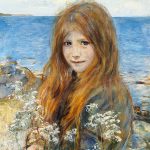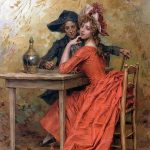Louis Franciscus Hendrik Apol, born on September 6, 1850, in The Hague, Netherlands, was a distinguished Dutch landscape painter, particularly celebrated for his winter scenes and depictions of the snow-covered forests and ice-bound waterways of the Netherlands. Apol’s work is emblematic of the Hague School, a movement in the late 19th century that sought to capture the mood, light, and atmosphere of the Dutch landscape through a subdued palette and attention to naturalistic detail. His paintings, characterized by a delicate interplay of light and shadow and a profound sense of tranquility, evoke the silent beauty of the Dutch winter landscape, making him a unique figure in the realm of landscape painting.
From a young age, Apol showed an exceptional talent for drawing and painting, leading him to study at the Royal Academy of Art in The Hague. Unlike many of his contemporaries who sought inspiration in the bustling cities or the pastoral countryside, Apol was drawn to the serene and often desolate beauty of winter. His ability to capture the nuances of snow, from the softness of a fresh fall to the harshness of a snowstorm, and his sensitive portrayal of the effects of light on the snowy landscape, set his work apart.
One of the defining moments in Apol’s career was his participation in an expedition to the Arctic in 1880 aboard the SS Willem Barents. This journey provided him with a wealth of inspiration and material that influenced his work for years to come. The dramatic landscapes of the Arctic, with their expansive ice fields, towering icebergs, and the ethereal northern lights, found their way into Apol’s paintings, enriching his palette and broadening his thematic repertoire. These Arctic scenes are among his most dynamic works, capturing the awe-inspiring beauty and formidable power of the natural world.
Apol’s winter landscapes are not merely representations of the physical environment but are imbued with a sense of emotional depth and introspection. His scenes are often devoid of human presence, or when figures are included, they are dwarfed by the vastness of the landscape, emphasizing the solitude and majesty of nature. This focus on the landscape as the primary subject matter, along with his nuanced understanding of light and atmosphere, aligns Apol’s work with the broader objectives of the Hague School, which sought to evoke the emotional and spiritual aspects of the Dutch landscape.
Throughout his career, Apol enjoyed considerable success and recognition. His works were exhibited internationally and collected by art lovers and institutions, both in the Netherlands and abroad. Despite the changing trends in art towards the end of his life, Apol remained committed to his unique vision, continuing to explore the beauty and mystery of the winter landscape.
Louis Apol passed away on November 22, 1936, in The Hague, leaving behind a legacy that continues to captivate and inspire. His paintings serve as a testament to his profound love and understanding of the natural world, offering viewers a glimpse into the tranquil and timeless beauty of the Dutch winter. Through his mastery of light, color, and composition, Apol not only contributed significantly to the Hague School but also established himself as one of the foremost landscape painters of his time, celebrated for his singular dedication to capturing the essence of winter.






